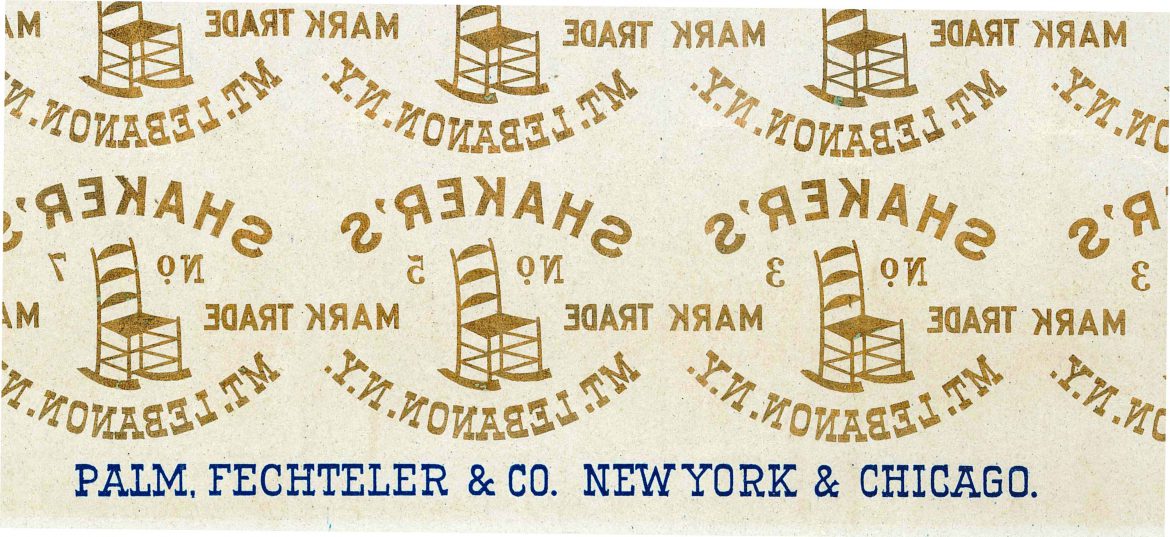
Sheet of Decalcomanias for Shaker’s Chairs, Palm, Fechteler & Co, New York and Chicago, South Family, Mount Lebanon, NY, Shaker Museum | Mount Lebanon.
With the rising success of Mount Lebanon’s South Family chair business in the 1860s and early 1870,s the Shakers were confronted with a number of companies making “knock-offs” of their chairs and marketing them as “Shaker.” The Henry I. Seymour Chair Manufactory in Troy, New York, the L. & G. Stickley Company in Fayetteville, New […]
With the rising success of Mount Lebanon’s South Family chair business in the 1860s and early 1870,s the Shakers were confronted with a number of companies making “knock-offs” of their chairs and marketing them as “Shaker.” The Henry I. Seymour Chair Manufactory in Troy, New York, the L. & G. Stickley Company in Fayetteville, New York, and the Enterprise Chair Manufacturing Company, in Oxford, New York, all produced chairs that were either called “Shaker” or were so stylistically similar to chairs made by the Shakers that the Shakers felt it necessary to warn their customers about the deception. In their 1874 catalogue, the Shaker published the following:
“Beware of imitation chairs which are sold for our make, and which are called Shakers’ chairs. Read, and remember where you can send for the Shakers’ chairs and get the genuine. Send your orders to headquarters, as we have only one price and quality to all consumers, and by this hall all men know that they are getting the genuine article.”

Catalogue, “Illustrated Catalogue and Price List of the Shakers’ Chairs, H. F. Reynolds, Lebanon Springs, N. Y., 1875, Shaker Museum | Mount Lebanon. Richmond Number 242, 1995.1.1.
The following year, to further protect their product from imitators, the Shakers developed a trade-mark for their chairs. The trade-mark appears on the back cover of their 1875 catalogue with the notice: “The above Trade-Mark will be attached to every genuine Shaker Chair, and none others are of our make notwithstanding any claims to the contrary.” The next year when the Shakers exhibited their chairs at the Centennial Exposition in Philadelphia, the special catalogue produced for that event added that their trade-mark “is a gold transfer, and is designed to be ornamental.” Even though the Shakers gave instruction on how to remove the trade-mark after it was purchased, most unrefinished chairs retain their trade-marks. The gold transfers, decalcomanias (decals for short), were produced by Palm, Fechteler & Company of New York and Chicago. This business began in 1856 as a company that decorated carriages, but around 1865, Charles Palm introduced decals to the United States. Decals originated in England in the mid-1750s as a way to add decoration to pottery – the pottery decorated in this way was commonly called transferware – but it was also a way to inexpensively add fancy decorations to carriages and most anything else. Almost any line art or lithographic print can be made in to a decal.

Die, South Family, Mount Lebanon, NY, ca. 1875, Shaker Museum | Mount Lebanon. 1957.8527.1.
It appears that the Shakers were experimenting with methods to trade-mark their chairs. While decals were a relatively new product in the U. S., there was a method for printing labels – hot stamping gold leaf on paper – that was well known to printers and bookbinders. The Shaker Museum|Mount Lebanon holds in its collection a die that was made to hot stamp gold leaf and a label made with the die that identified chairs as being Shaker made. While the manufacturer of the die is not known. It is noteworthy that the front and back covers of the Shakers’ 1875 chair catalogue, printed by B. F. Reynolds, a book and job printer, in Lebanon Springs, New York, appears to be stamped with gold leaf. The knowledge of how to make paper labels with gold lettering was only a short walk away from the Shakers at Mount Lebanon. A printer such as Reynolds certainly would have known where to obtain the proper die to print gold leaf labels. A second gold-leaf stamped label in the Museum’s collection is of a different size and style. To our knowledge the metal die used to make this label has not yet surfaced. The existence of the two different labels suggests that the Shaker were trying out different techniques to produce a practical trade-mark.

Label, “Shaker’s Mt. Lebanon, N. Y., Trade-Mark, No,” South Family, Mount Lebanon, NY, ca. 1875, Shaker Museum | Mount Lebanon, Acc. No.: 2003.20922.1.

Label, “Shaker’s Mt. Lebanon, N. Y., No. 4. Trade Mark,” South Family, Mount Lebanon, NY, ca. 1875, Shaker Museum | Mount Lebanon. 2003.20923.1.
One final observation about the Shakers’ adventures in trade-marking: both the decals made by Palm, Fechteler & Company and the die present the Shakers’ name in the singular possessive – Shaker’s – whereas, the Shakers seemed to prefer to use the plural possessive – Shakers’ – when they put their name on a product. This deviation suggests that either the Shaker who contracted with the maker of the die and with Palm, Fechteler & Company made the apparent error, or the Palm, Fechteler & Company made this decision and could have been the maker of the die as well as the decals.

Sheet of Decalcomanias for Shaker’s Chairs, Palm, Fechteler & Co, New York and Chicago, South Family, Mount Lebanon, NY, Shaker Museum | Mount Lebanon.